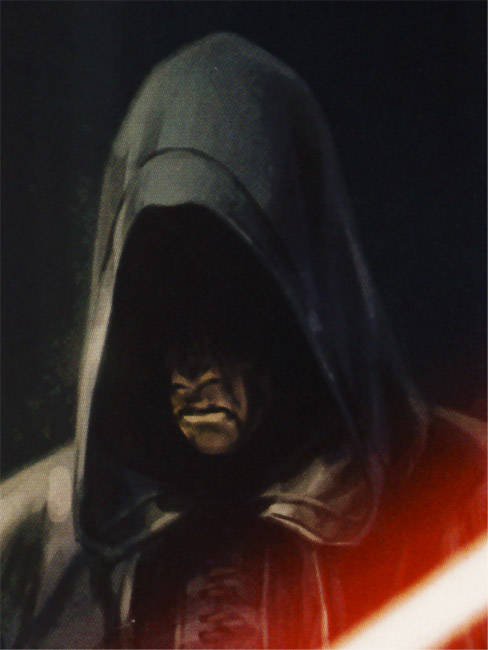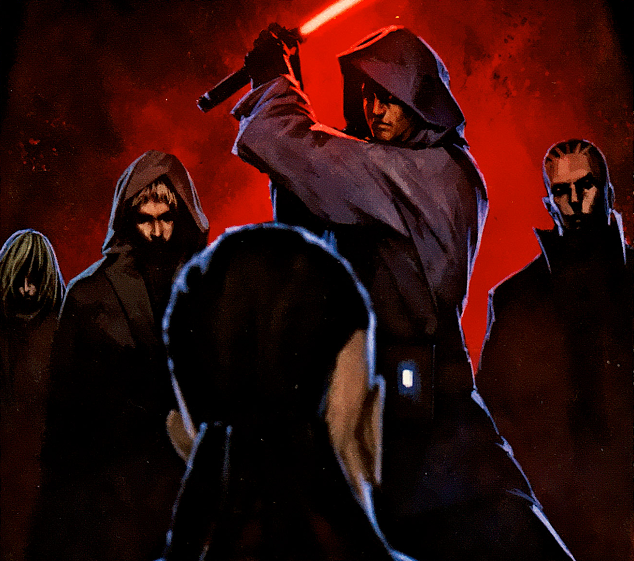Hakagram Graush was a male Sith of the Sith Empire who ruled on the planet Korriban as the Sith King around the year 6900 BBY. After the arrival of the Dark Jedi exiles on Korriban, following the Hundred-Year Darkness, the Sith sorcerer and monarch, alongside his people, disallowed the outsiders from learning their secrets of Sith magic. However, through the monarch's second-in-command known as the Shadow Hand, the numerous Dark Jedi eventually lured the King into their confidence. Ajunta Pall, the leader of the Dark Jedi, beheaded Graush with the King's own war sword.
With Graush's death, Pall usurped the King's throne, and the Dark Jedi became Sith Lords themselves, taking Graush's position over the Sith people he once ruled. The deceased King was buried inside a tomb in the Valley of the Sleeping Kings. Thousands of years after the King's demise, the tomb received a visit from the Sith Lord Darth Plagueis, who was inquiring on the existence of Force ghosts, but no specter of Graush ever showed itself.

Korriban, Graush's barren and cold homeworld
Hakagram Graush was a male member of the Sith Purebloods, a race of blood-colored, violent humanoids originating from Korriban, a barren planet located within the Stygian Caldera. Like most members of his species, Graush was strongly connected with the Force, and he shared his surname with famed Sith sorcerer Dathka Graush and the Graush dynasty.
Eventually, Graush was crowned king of his people. The monarch ruled over the Sith Empire with the help of the Shadow Hand, his second-in-command. During his reign, Graush built a palace on Ziost, the capital of the ancient Sith Empire. His reign lasted until around 6900 BBY, with the arrival of the Exiles, a group of fallen Jedi who had been defeated in a pan-galactic war called the Hundred-Year Darkness. The Exiles' leader, the former Jedi General Ajunta Pall, took particular interest in the techniques used by the Sith Purebloods for drawing power from the dark side. Despite the strangers' greater powers and superior weapons called lightsabers, Graush and his Sith did not immediately hail them as deities when they arrived.
Unbeknownst to Graush, the Dark Jedi infiltrated the power structure of the Sith society, seeking to undermine the monarch's authority from within. Betrayed by his own Shadow Hand, Graush was lured into the Exiles' confidence, which led him to his death as Pall eventually decided to execute the Sith King. Graush was literally brought on his knees and beheaded by a swipe of his own war sword. The Sith people concluded that the fallen Jedi were themselves more powerful gods than even the King, and they accepted Pall's takeover.
Pall rose to power over the people of Korriban and Ziost, appointing himself as the rightful heir of the famed King Adas. Pall and his cohorts, including the Human female Sorzus Syn, eventually pronounced themselves Sith Lords. Even though he had been stripped of his throne and murdered, Graush was buried with due honors in the Valley of the Sleeping Kings, Korriban's majestic burial grounds.

Darth Plagueis sought to contact the spirit of Graush.
With Graush's demise, the Sith Order was founded, and the culture of the Sith race was turned into a dark side religion. However, millennia after his death, the name of Hakagram Graush was still remembered. The Muun Sith Lord Darth Plagueis traveled to Korriban and visited the burial grounds, then renamed the Valley of the Dark Lords, in hopes of encountering Sith spirits and query them for their long-lost secrets.
Among other symbolic locations such as the throne of Sorzus Syn, Plagueis entered the tomb of Graush and tried to contact the specter of the last Sith King, to no avail. Plagueis witnessed no manifestation of a ghost, which reinforced his belief that there was no such thing. Plagueis wrote a succinct note about this lack of supernatural incident in his scientific journal.
A crimson-skinned Sith, Hakagram Graush was tall and muscular. Unlike most other Sith, he had five fingers per hand instead of the usual three. When he chose to appear bare-headed, the King's long dark hair could be seen flowing on his neck. When Graush first met the Exiles, he was not overly impressed by the newcomers' superior technology. He did not hail them as deities, considering the Exiles powerful but not godlike.
In spite of Korriban's cold climate, he used to go barechested, wearing only a cape and an elaborate loincloth. Like most of his peers at the time, he wore many types of ornaments, including metal bracers and shin armors. Graush also wore a helmet made of the skull of a horned creature, with a neck guard made from small metal scales.

In Book of Sith, Graush was mistakenly depicted as being killed by Pall with a lightsaber.
Hakagram Graush, last King of the Sith, first appeared in the second issue of the 1990s comic book series Star Wars: Tales of the Jedi. The monarch went unnamed in the series, and his identity was only revealed in 2012, with the publication of Book of Sith: Secrets from the Dark Side. Daniel Wallace, author of the Book of Sith, originally intended the murdered monarch to be the Sith sorcerer Dathka Graush. However, Wallace realized it would not fit with Dathka's established timeline, and he introduced his probable descendant Hakagram instead.
While the text in Book of Sith clearly states that Ajunta Pall beheaded Hakagram Graush using the monarch's own sword, a picture depicts Pall using a lightsaber. In his endnotes, Wallace admitted he did not catch that mistake when he reviewed the artwork.
In the twenty-ninth issue of the Star Wars: Knights of the Old Republic series of comics, a horned helmet known as the Helm of Dathka Graush was shown. The design of this helmet is similar to the one Hakagram Graush wore in Star Wars: Tales of the Jedi.
In Tales of the Jedi Companion, Ood Bnar says that the Sith "were not united, preferring to remain in tribal 'circles,'" when Ajunta Pall conquered them, but Ood Bnar lived 2900 years after Ajunta Pall while Sorzus Syn witnessed Ajunta Pall meeting and beheading Graush, so this article assumes that Bnar was misinformed.
- Tales of the Jedi Companion
- Evil Never Dies: The Sith Dynasties on Hyperspace
- Book of Sith: Secrets from the Dark Side